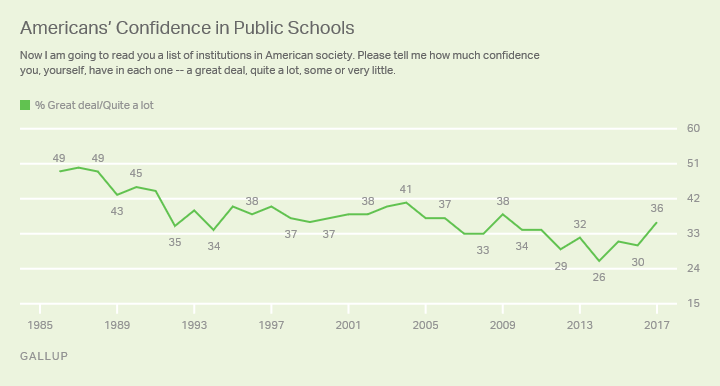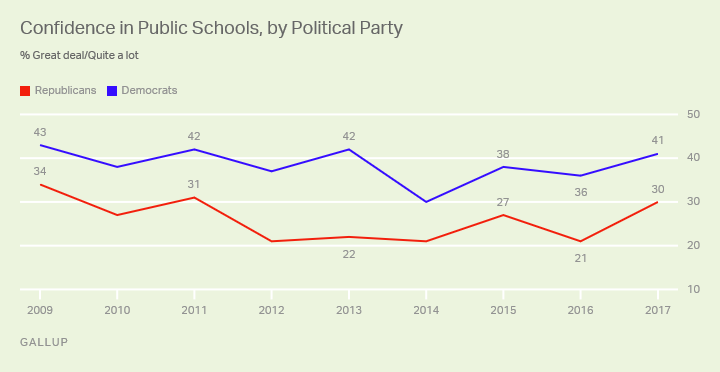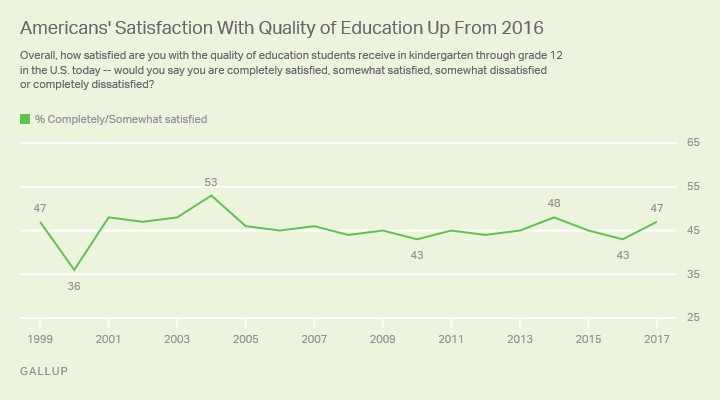Confidence in U.S. Public Schools Rallies
Americans' confidence in the nation's public schools edged up in 2017. The 36% of U.S. adults who express "a great deal" or "quite a lot" of confidence in public schools is a six-percentage-point increase from 2016 and marks the highest confidence rating in eight years.

Gallup has measured Americans' confidence in public schools since 1986. Confidence hit its lowest point in 2014, when about one in four U.S. adults (26%) expressed confidence in the nation's public schools. This low was nearly half the high mark of 50% in 1987.
The boost in public school confidence this year is part of an uptick in the average confidence rating (35%) across all institutions that Gallup measures. Public school confidence ranked second in positive year-over-year change among 15 institutions tested in the June survey. Eleven institutions received a confidence boost from 2016, largely attributable to rising confidence among Republicans, which might be ascribed to the election of President Donald Trump.
The upswing in confidence in public schools from 2016 to 2017 is evident among both Republicans (up nine points) and Democrats (up five points). The tendency for Democrats to be more confident than Republicans in public schools has been generally constant over the past nine years, and is evident this year, with 41% of Democrats and 30% of Republicans confident in public schools.

The 11-point spread between Democrats and Republicans is much smaller than the 23-point gap in partisan confidence in "colleges and universities" measured in a separate poll in August. The wider party gap in ratings of higher education appears to reflect Republicans' perception that a liberal political agenda is driving what is taught in colleges -- a perception that apparently has not spread to their views of public schools.
This year's bump in confidence in public schools parallels the increase in Americans' satisfaction with public school education as measured in Gallup's annual Work and Education survey, conducted in August. Nearly half of U.S. adults (47%) say they are "completely" or "somewhat" satisfied with the quality of education for K-12 students, up four percentage points from 2016 but still trailing the high mark for satisfaction (53%) that occurred in 2004.

Implications
While U.S. public schools have struggled to boost their national image in the past decade, there is a hint of progress. The six-point improvement in confidence in public schools from 2016 to 2017 matches the largest year-over-year positive change for schools in Gallup's trend.
Some recent education successes may be helping to nudge confidence in schools upward. The Every Student Succeeds Act, a bipartisan measure signed by President Barack Obama in December 2015, provides increased autonomy and flexibility for state and local education agencies to steer innovation and accountability measures -- and Gallup research suggests that Americans are more trusting of local than federal government. Additionally, the U.S. graduation rate is now at an all-time high of 83%, and the dropout rate is down.
Gallup research shows the nation's public school leaders are likewise optimistic about their school systems. A recent poll of U.S. superintendents shows a significant majority (85%) are excited about their district's future. However, there is clearly more work to be done to improve the quality of education and how it is perceived. Just 32% of these school leaders say they are excited about the future of U.S. education generally -- a percentage that aligns closely with the 36% of Americans expressing confidence in the nation's public schools.

